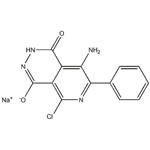sodium 8-amino-5-chloro-1-oxo-7-phenyl-2H-pyrido[3,4-d]pyridazin-4-olate manufacturers
- L 012 sodium salt
-

- $51.00 / 1mg
-
2025-11-04
- CAS:143556-24-5
- Min. Order:
- Purity: 98.70%
- Supply Ability: 10g
- L 012 sodium salt
-

- $3.90 / 100KG
-
2025-10-13
- CAS:143556-24-5
- Min. Order: 1KG
- Purity: 99%
- Supply Ability: g-kg-tons, free sample is available
|
| | sodium 8-amino-5-chloro-1-oxo-7-phenyl-2H-pyrido[3,4-d]pyridazin-4-olate Basic information |
| Product Name: | sodium 8-amino-5-chloro-1-oxo-7-phenyl-2H-pyrido[3,4-d]pyridazin-4-olate | | Synonyms: | 8-Amino-5-chloro-2,3-dihydro-7-phenyl-pyrido[3,4-d]pyridazine sodium salt;1H-Benz[e]indole-6,8-disulfonic acid, 1,1,2-trimethyl-;sodium 8-amino-5-chloro-1-oxo-7-phenyl-2H-pyrido[3,4-d]pyridazin-4-olate;L 012 sodium salt;8-Amino-5-chloro-7-phenyl-2,3-dihydropyrido[3,4-d]pyridazine-1,4-dione sodium salt;L 012 sodium salt, 10 mM in DMSO | | CAS: | 143556-24-5 | | MF: | C13H8ClN4NaO2 | | MW: | 310.67099 | | EINECS: | | | Product Categories: | | | Mol File: | 143556-24-5.mol | ![sodium 8-amino-5-chloro-1-oxo-7-phenyl-2H-pyrido[3,4-d]pyridazin-4-olate Structure](CAS/20180529/GIF/143556-24-5.gif) |
| | sodium 8-amino-5-chloro-1-oxo-7-phenyl-2H-pyrido[3,4-d]pyridazin-4-olate Chemical Properties |
| storage temp. | -20°C | | solubility | Soluble to 20 mM in water and to 100 mM in DMSO | | form | Solid | | color | White to yellow | | Water Solubility | H2O: 2mg/mL, clear | | InChI | InChI=1S/C13H9ClN4O2.Na/c14-11-8-7(12(19)17-18-13(8)20)9(15)10(16-11)6-4-2-1-3-5-6;/h1-5H,15H2,(H,17,19)(H,18,20);/q;+1/p-1 | | InChIKey | IGEUYSJHQQCEFP-UHFFFAOYSA-M | | SMILES | [Na+].C1([O-])=NNC(=O)C2=C(N)C(C3=CC=CC=C3)=NC(Cl)=C12 |
| | sodium 8-amino-5-chloro-1-oxo-7-phenyl-2H-pyrido[3,4-d]pyridazin-4-olate Usage And Synthesis |
| Description | L 012 sodium salt is a luminal-based chemiluminescent dye and probe. It is used to detect superoxide in biological systems, specifically in whole inflammatory cells, vascular tissue and blood. It could detect NAPDH oxidase-derived reactive oxygen and nitrogen species (ROS and RNS). It is active in vitro and in vivo. | | Uses | L 012 Sodium Salt is a chemiluminescent dye used to detect superoxide in biological systems, specifically in whole blood, inflammatory cells, and vascular tissue. | | Biological Activity | L-012 is a luminol analog and a widely used reactive oxygen and nitrogen species (RONS; ROS & RNS) chemiluminescence (CL) probe both in cultures and in animals in vivo. L-012 displays significantly higher CL yield and sensitivity than luminol, lucigenin and MCLA. Instead of reacting with superoxide anion (O2-) directly, L-012 (LumH2) is converted via a one-electron oxidation (catalyzed by peroxidase in the presence of H2O2) to the LumH· radical form, which then reacts with oxygen (O2) to yield O2- and L-012 quinone (q-Lum). The O2- in turn reacts with the LumH· radical, leading eventually to an endoperoxide th at decomposes to emit luminescence. To a less extend, H2O2 can also react with q-Lum to yield luminescence. Although not specific to NADPH oxidase-derived RONS, L-012 is also commonly used for screening NADPH oxidase inhibitors. | | in vivo | L-012 sodium salt is well distributed in the mouse body and mediates a strong ROS/RNS-dependent luminescent signal in vivo and is useful for monitoring the development and regulation of inflammation in living organisms[2]. | | storage | Store at -20°C |
| | sodium 8-amino-5-chloro-1-oxo-7-phenyl-2H-pyrido[3,4-d]pyridazin-4-olate Preparation Products And Raw materials |
|